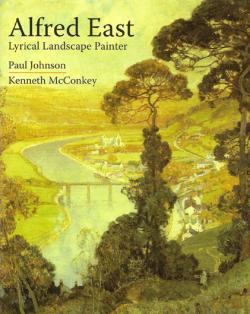Alfred East Lyrical Landscape Painter

Published by Sansom and Company, Bristol, 2009, ISBN 978-1-906593-33-9, 1444 pages including illustrations, bibliography and index.
Review by Sir Hugh Cortazzi
Sir Alfred East RA (1844-1913) was a founder member of the Japan Society in 1891. He was commissioned by Marcus Huish, director of the Fine Art Society in New Bond Street in 1888 to “paint the landscape of Japan.” He travelled to Japan with Charles Holme and Lazenby Liberty who were also fascinated by Japan. East’s diary of this visit was published in 1991 under the title A British Artist in Meiji Japan (edited by me and published by In Print). As Paul Johnson writes in this volume “Many of the subjects painted by East …were the typical sites of interest to foreign visitors but some were pure landscapes. East saw through European eyes, of course, but what was unique about his pictures when compared with those of other visiting British artists was the atmosphere he created with his skilled use of watercolour to produce translucence and to capture the rain and mists and the various moods of the landscape as they changed with the weather.” Ten paintings by Alfred East are reproduced in this book. I was particularly struck with the following picture entitled “An Angry Night” which even in this reproduction shows his use of colour and shade:
East was born in Kettering in 1844 as the son of a boot-maker and he started in business with his brother who was twenty years his senior. He developed gradually into a landscape painter. Apart from painting English scenes he travelled widely in Europe and the United States. He later became a decorator, etcher and educator. Reproductions of his paintings in this volume are divided into sections entitled “Earlier British pictures,” Japan, France, Italy, Venice and Sicily, Spain and Egypt and Later British works.
The introductory part of the book covers his life and career until his death in 1913. His relationships with the Royal Academy and the RBA are discussed. Kenneth McConkey writes about “East and the Edwardian Grand Tour” in an essay entitled “Picturesque Imperialist.” East may not have achieved the highest accolades from the critics but Edmund Gosse who was a leading critic of the early decades of the twentieth century declared at the opening of the Kettering Gallery, which East created, that he was an artist “who was first and last a painter of exquisite distinction and full of originality.”

